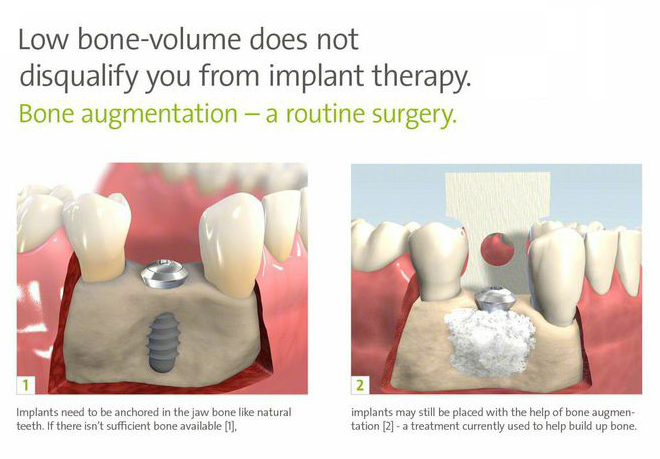When teeth are lost, sometimes the bone around them is lost as well. If so this may need to be built back up if implants are to be placed. There are various types of bone regeneration that may be required in different situations. If you need one of these we will explain to you why and how this is carried out. Not everyone needs this as part of the treatment.
This is carried out at the time of implant placement if some of the implant is exposed due to thin bone. You will be unaware of the procedure apart from taking a few more minutes of surgery time. Special materials are added around the implant where there are small deficiencies in your own bone. This will help to maintain the look of the implant crown where it comes out of the gum and allow bonen to grow over the implant keeping it strong. There are various materials to choose from for this technique, and we have chosen our favoured materials following careful research.

The bones that make up your face are hollow and contain air spaces known as sinuses. The sinuses that sit above your upper back teeth are known as the maxillary sinuses. When an upper posterior tooth is lost, the bone that surrounds the roots dissolves away. As a result, the floor of the maxillary sinus drops down into the space formerly occupied by the roots of the lost tooth.
In order to place an implant, there needs to be sufficient depth of bone in which to place the implant. In upper molar areas, it is sometimes necessary to put the sinus floor back up to where it originally was by adding a bone substitute in order to create enough bone. This procedure is called a sinus floor bone augmentation or a 'sinus lift'. There are a variety of ways that this can be done and we can talk you through the process.
A sinus lift involves carefully placing a bone substitute material into the sinus area. This material will become incorporated into the surrounding bone acting like a scaffold, allowing your natural bone to grow into the area. After a period of healing, usually around 6 months, the area is again checked for suitability and providing all is well, your implant can then be placed.
In some cases, it is possible to carry out the sinus bone regeneration and place the implant in one stage thus avoiding the need for two procedures.